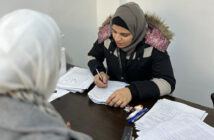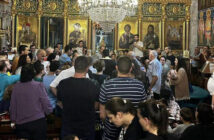Source: Pravoslavie.ru
Oleg Glagolev, Igumen Arseny (Sokolov)
Igumen Arseny (Sokolov), representative of the Patriarch of Moscow and All Russia at the Patriarch of Antioch and All East, Rector of the Representation of the Russian Orthodox Church in Beirut, answers questions from the Yekaterinburg-based S-T-O-L (Stol.com) media-project.

Fr. Arseny (Sokolov)
—Fr. Arseny, now you serve in the hottest spot on the Earth. Please, tell us of the present situation of the Orthodox Church in Lebanon and Syria. How many priests, parishioners, monasteries, convents and churches do they have? Which churches and historic places are the most popular?
—The Church of Antioch has several dioceses in both Syria and Lebanon, there are also dioceses and parishes in other countries of the Middle East region. The larger part of the flock of the Church of Antioch reside in both Americas—North America and South America. Several of the largest dioceses are concentrated there. There are also a number of dioceses in Europe along with a diocese in Australia. Moscow has a Representation of the Patriarchate of Antioch which has been headed by Metropolitan Niphon (Saikali) for many years. The Convent of Our Lady of Saidnaya and Convent of St. Thecla in Ma’loula are among the best known monastic centers in Syria, and there are also sites associated with stylites (pillar ascetics) of ancient times, but some of these places, unfortunately, have now been seized by terrorists. Lebanon has many active Orthodox monastic communities: five monasteries for men and seven convents. One of them, Balamand Monastery, has the Theological Institute of St. John of Damascus founded by the deceased Patriarch Ignatius IV of Antioch (1920-2012), predecessor of the current Patriarch John X. This is the only Orthodox theological institute in the Middle East. It prepares theologians and pastors not only for the Middle East region, but also for Latin America. At present the institute even has one student from Russia. Here, in Balamand, the Lebanese residence of the Patriarch of Antioch, is located; it is currently the main patriarchal residence, because of the war in Syria.
In Lebanon I have managed to visit all the dioceses, monasteries and convents of the Patriarchate of Antioch, in Syria—only in Damascus and Ma’loula. I seldom have an opportunity to travel to Syria, but when I visit it I celebrate services at the Church of St. Ignatius the God-Bearer of Antioch at the Representation of the Patriarchate of Moscow, and also visit the Church of Mariamia—at the Patriarchate of Antioch—and the embassy of the Russian Federation in Damascus, as many of its officials are believers.
—Can you tell us about your parish in Beirut?
—There is a small parish at the Representation of the Patriarchate of Moscow comprising, mainly, wives and children of Lebanese men along with descendants of the first wave of the Russian emigration—children and grandchildren of White Guard. The parish was established back in 1946. The faithful come here from around Lebanon; on Sundays and feast-days our parish gathers several dozen people—forty-fifty. Now the majority of our parishioners are women. Many of them came from the former Soviet Union, Russia, the Ukraine, and Kazakhstan. There are also wives of Lebanese men with various religious backgrounds: Shia and Sunni Moslems, Druze, Maronites, Catholics, Orthodox, and Syro-Jacobites.
—And how do non-Christian husbands relate to the Orthodox faith of their spouses?
—Differently. In most cases they have no problem with it, but some women attend church without their husbands’ knowledge. The Shia themselves customarily bless their Christian wives to attend Orthodox churches.
—Surely there must be some descendants of famous Russian families in your parish. Is it so?

The Antiochian Orthodox Church in Hamah.
—Yes. One of such parishioners is a grandson of the Russian painter Valentin Serov (1865-1911)—Gregory Alexandrovich Serov, an architect. Recently he took part in the opening of an exhibition of his grandfather’s works at the Tretyakov Gallery in Moscow. Our churchwarden is Irina Alexeyevna Zhaber—a daughter of the White Army officer Alexei Ler, who fought in Wrangel’s army. Not long ago we buried the pharmacologist and pharmaceutist Peter Malyshev, who was famous in Lebanon. There is also Fyodor Raskatov, son of Stephan Xenophontovich Raskatov, who organized the cadastral system of all Lebanon in the 1940s and 1950s. All of them speak Russian fluently, while the third generation of the White Guard does not know Russian, but speaks Arabic and French.
—What was your first impression of the country, churches, services, customs, language, and the faithful?
—Liturgies of the Church of Antioch were very much under Greek influence, they became “byzantinized”, and to date all what they preserve is their native Arabic. Syro-Jacobites and Syrian Catholics have preserved the Syrian rite.
Of course, I am under a strong impression of the antiquities, the cyclopean stone structures of Baalbek; the rock reliefs and inscriptions near Beirut, at the mouth of the Nahr el-Kalb (the Dog River)—the earliest of them was carved under Pharaoh Ramses II the Great (ruled in 1279-1213 B.C.), and the last one—late in the twentieth century.
The Christian East embraces 2000 years of history, and here we have a much longer history, since Lebanon and Syria are the Biblical lands. It was in Sarepta (or Zarephath)—modern Sarafand—between Tyre and Sidon (also known as Sour and Saida), that the Holy Prophet Elijah (Elias) raised the widow’s son to life; and it was in the region of Tyre and Sidon that our Lord Jesus Christ travelled and healed the daughter of a Canaanite (Syrophoenician) woman, according to the Gospels. The apostles visited Tyre as well, as recounted in the Acts. The port that, beyond all doubt, they used still exists there. The Roman hippodrome where many Christian martyrs were murdered in the third-fourth centuries is intact as well. Each Christian wishes to walk along Straight Street (Via Recta) in Damascus, mentioned in the Acts, and to visit the house in which St. Ananias baptized Saul, future Apostle Paul. I happened to visit them too.
Unlike Jerusalem, which was twice destroyed to its very foundations, in 70 and 135 A.D. (where all the names of streets and historic places were invented by Franciscans), Damascus—the oldest capital in the world—was never utterly devastated, so many of its streets, buildings, and historic sites have preserved their ancient names.
—Syria, the oldest Christian land, was in 2015 on a list of the top five countries where the persecution of Christians was the worst. What kind of spirit prevails among Christians today: to leave their native land, to oppose the persecutors by word and prayer, or to take up arms?
—Patriarch John of Antioch says: this is our land and we will remain here. Other patriarchs are calling upon their flocks not to go anywhere either. Look at what is going on in Iraq: nine tenths of the country’s population has left it over the past 20 years…
Christians are unwilling to leave Syria. It is their land, their native home… The Middle East is the cradle of Christianity, Christians had appeared here six centuries before the arrival of Muslims. If Christians disappear from the Middle East, this region will lose the most important part of its identity and will become monotonous, depressed and dull, like United Arab Emirates or something.
—Not only are Christians being persecuted in Syria, but also the Alawites and moderate Sunnis (for example, the murder of Imam Ramadan al-Bouti). Do you see any consolidation of the faithful from different confessions in the face of persecutions? Are there any examples of that?

Escape of Christians from Syria.
—Before the war Syria was a model of peace and good-neighborliness: representatives of all the religions and confessions peacefully coexisted here through the centuries. As a matter of fact, it is still the case there: Syrians are a very kind-hearted and peaceful nation, and the international terrorist hordes that penetrated their country have not been able to break their inner religious peace, which is in the hearts of the Syrian people and their being. Everybody knows here that it is not a civil war that is going on: this is a terrorist war which was imposed from outside.
How do people live here? Residential areas of Damascus are built up with nine and twelve-storied blocks of the Soviet-style architecture of the Brezhnev era (1964-1982). Sunnis, Alawites, Catholics and Orthodox dwell on the same stair landing. And it is not considered polite to ask about each other’s faith. Neighbors greet each other on festivals and invite each other for a holiday meal. This good-neighborhood has existed and developed for centuries, even for thousands of years. Syrians do not fight against other Syrians; and though they are at war today, this is because the international terrorist forces have split them up. But that is not an inner Syrian conflict.
—Many call Syria and the Middle East “the cradle of Christianity”. What will be the impact of this cradle’s devastation on Christendom?
—Some 1500 years ago the whole of the Middle East was Christian. So also were all Turkey, entire North Africa and even Central Asia. Libya alone had over 400 (!) Christian bishops before the Muslim invasion; that means more than the total number of bishops of the Russian Orthodox Church today! And will we find at least one Christian bishop in Libya now? Few people remember this, but the evangelization of today’s Pyrenees (that is, Portugal and Spain) in the third-fourth centuries took place directly from North Africa: missionaries from Carthage brought Christianity to the south-west corner of Europe. Terrible events are happening in the world, but optimism is inherent in Christians, and we are aware that the history, including the history of the Church, is in the Hands of God. And we can find appropriate words of consolation in books of all the prophets. All is in the power of the Almighty, all the human actions on the Earth are allowed by Him and nothing happens without His will; the power belongs to the Creator and soon it will belong to Him only.
—To what extent, in your view, this war is a historical, political and spiritual event?
—The fate of mankind was always decided in the Middle East. And it is also the case now. So, all three aspects that you have enumerated are now interconnected. When in the eighth century B.C. the Assyrian hordes were terrorizing and destroying the whole of the Middle East, God allowed this to happen. But everything comes to an end sometime. So the prophecy of St. Nahum was fulfilled and the Assyrian empire ceased to exist. “Here I am against thee, saith the Lord of the hosts, and I will uncover thy skirts upon thy face, and I will show the gentiles thy nakedness and the kingdoms thy shame. And I will cast abominable filth upon thee and make thee vile and will set thee as dung…” (Nahum 3:5,6).
In the time preordained by the Almighty the new “Assyrians”—the terrorists which are active in the Middle East today—will perish too.

The old Christian district of Al-Jdayde in Aleppo.
—Patriarch Kirill visited Syria and Lebanon in 2012 and said then that the Russian Orthodox Church supported religious freedom for all in the Middle East. This can often be heard in Russia. And how do your people feel this support?
—The Russian Orthodox Church together with its primate firmly raises its voice in defense of the persecuted Christians of the Middle East and North Africa and stands for the religious freedom for all in these regions. The Russian Church is praying and will keep praying for the peace in the Middle East. Jointly with the Imperial Orthodox Palestine Society our Church constantly collects donations and sends humanitarian aids here. Recently a considerable sum of money was raised by common folk in parishes. I know that the Moscow Novospassky Monastery and the Church of the Renewal of the Temple of the Resurrection of Christ in Jerusalem in Uspensky Vrazhek in Moscow (where Archpriest Nikolai Balashov is rector) collected donations and sent them here. The building of a school for children in Damascus is being discussed along with a hospital in Syria with the support of the Russian Orthodox Church, and there are other humanitarian projects. Other Christian denominations and organizations do not stand aloof: for instance, Catholics (Caritas International etc) are actively helping refugees.
—Upon what and whom do Syrian Christians set their hopes for peace today?
—Upon Christ the King, Whose Kingdom shall have no end.
Photos by Stol.com.
Translation by Dmitry Lapa



